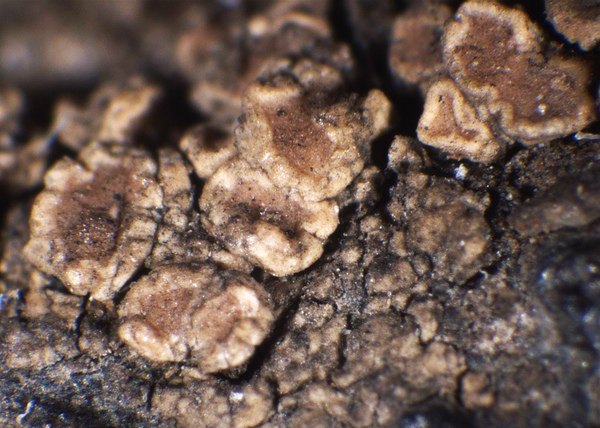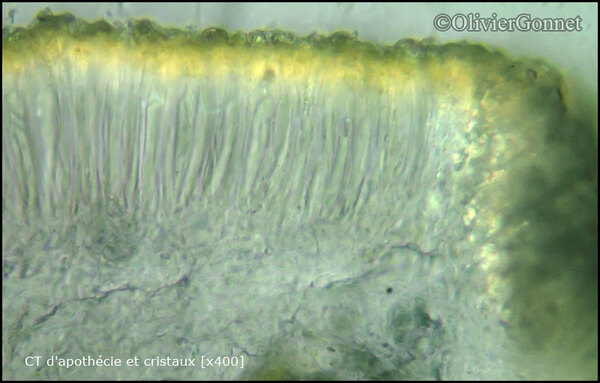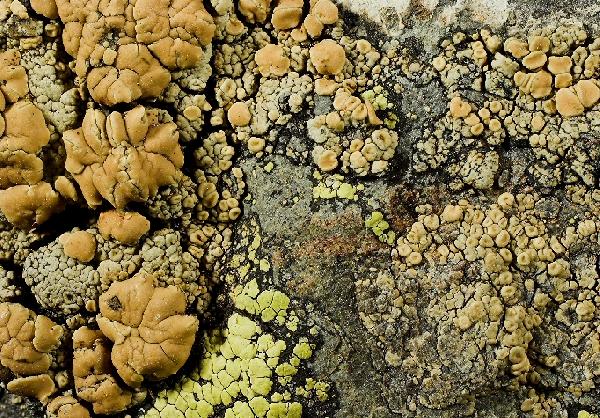Lecanora stenotropa Nyl.
Flora, 55: 251, 1872.
Synonyms:
Distribution: N - Piem.
Description: Thallus crustose, endosubstratic or thinly episubstratic, yellowish or greenish yellow, sometimes with a brownish hue, continuous to granulose, sometimes forming an areolate crust, the granules contiguous, 0.1-0.2 mm wide, slightly convex. Apothecia lecanorine, sessile, round to irregular in outline, 0.5-1(-1.3) mm across, with a pale yellow-green to pale greenish brown, epruinose, flat to convex disc, and a thin, often finally excluded thalline margin. Thalline exciple corticate, with sparse algae, lacking crystals, laterally 30-70 µm wide, basally up to 110 µm wide; proper exciple colourless, 25-50 µm wide; epithecium brownish, without crystals; hymenium colourless, 45-60 µm high, I+ blue; paraphyses coherent, sparingly branched and anastomosing, 1.5-2 µm thick at mid-level, the apical cells up to 2.5 µm wide; hypothecium pale yellowish brown. Asci 8-spored, clavate, Lecanora-type. Ascospores 1-celled, hyaline, narrowly ellipsoid, 7-14 x 2.5-4 µm. Spot tests: thallus K-, C-, KC+ yellowish, P-. Chemistry: isorangiformic acid, usnic acid and zeorin. Note: this silicicolous species, which is closely related to L. polytropa, is apparently quite widespread and locally common along the southern Alps (Roux & coll. 2014). Several other records might be hidden among those of L. polytropa.
Growth form: Crustose
Substrata: rocks
Photobiont: green algae other than Trentepohlia
Reproductive strategy: mainly sexual
Commonnes-rarity: (info)
Alpine belt: absent
Subalpine belt: rather common
Oromediterranean belt: absent
Montane belt: very rare
Submediterranean belt: absent
Padanian area: absent
Humid submediterranean belt: absent
Humid mediterranean belt: absent
Dry mediterranean belt: absent
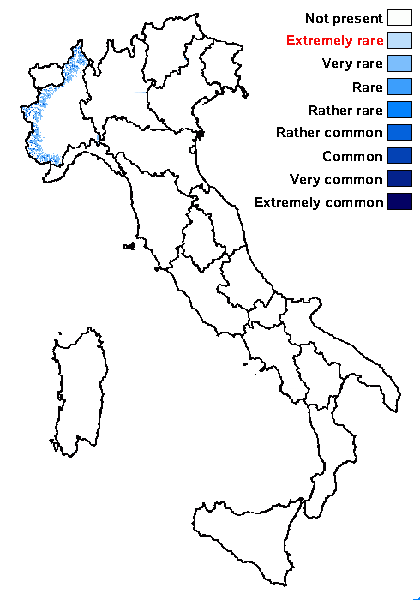
Predictive model

S. Poumarat - Source: Roux C., Bertrand M., Poumarat S., Uriac P. 2022. Quelques espèces nouvelles saxicoles – calcifuges de Lecanora du groupe polytropa (Ascomycota, Lecanoraceae) découvertes en France. Bull. Soc. linn. Provence, 73: 79-120.
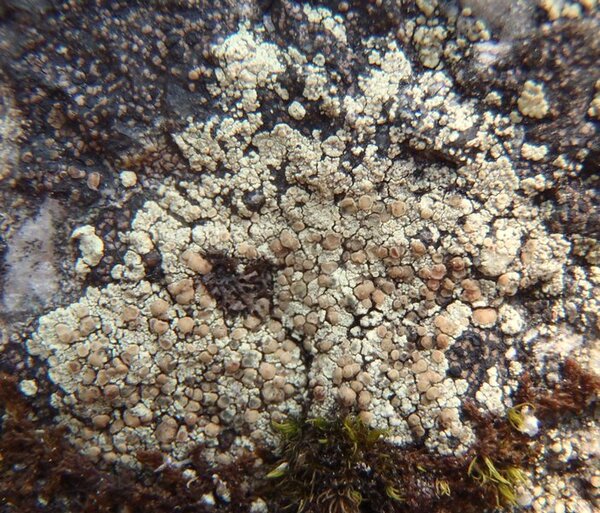

Curtis Randall Björk – CC BY-SA 4.0
British Columbia, Clearwater Valley Date: 2012-04-07 On basalt boulder in mixed conifer-deciduous forest
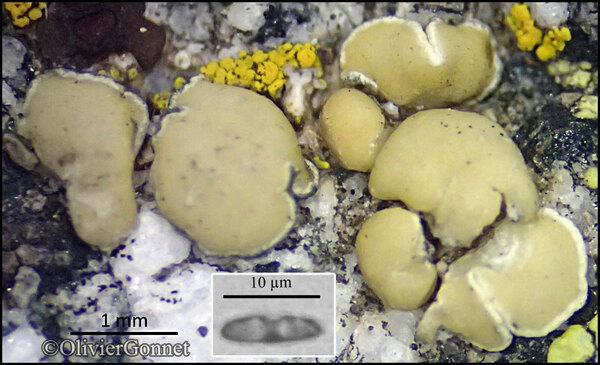
Courtesy Danièle et Olivier Gonnet - Source: https://www.afl-lichenologie.fr/Photos_AFL/Photos_AFL_L/Lecanora_stenotropa.htm
France, Sur granite - Coscione Bergeries de Chiralbella, alt. 1600 m, Quenza - Corse
7/10/2014
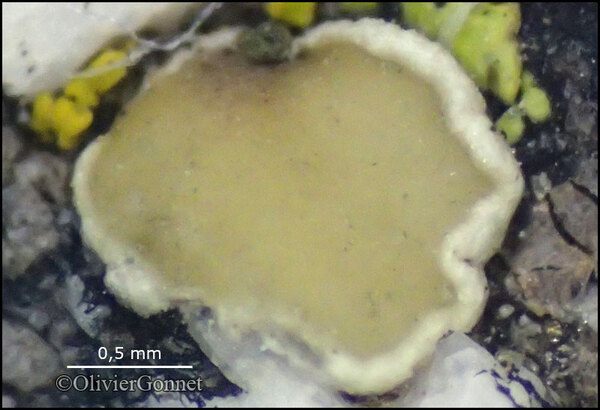
Courtesy Danièle et Olivier Gonnet - Source: https://www.afl-lichenologie.fr/Photos_AFL/Photos_AFL_L/Lecanora_stenotropa.htm
France, Sur granite - Coscione Bergeries de Chiralbella, alt. 1600 m, Quenza - Corse
7/10/2014

Courtesy Danièle et Olivier Gonnet - Source: https://www.afl-lichenologie.fr/Photos_AFL/Photos_AFL_L/Lecanora_stenotropa.htm
France, Sur granite - Coscione Bergeries de Chiralbella, alt. 1600 m, Quenza - Corse
7/10/2014
Growth form: Crustose
Substrata: rocks
Photobiont: green algae other than Trentepohlia
Reproductive strategy: mainly sexual
Commonnes-rarity: (info)
Alpine belt: absent
Subalpine belt: rather common
Oromediterranean belt: absent
Montane belt: very rare
Submediterranean belt: absent
Padanian area: absent
Humid submediterranean belt: absent
Humid mediterranean belt: absent
Dry mediterranean belt: absent

Predictive model

S. Poumarat - Source: Roux C., Bertrand M., Poumarat S., Uriac P. 2022. Quelques espèces nouvelles saxicoles – calcifuges de Lecanora du groupe polytropa (Ascomycota, Lecanoraceae) découvertes en France. Bull. Soc. linn. Provence, 73: 79-120.


Curtis Randall Björk – CC BY-SA 4.0
British Columbia, Clearwater Valley Date: 2012-04-07 On basalt boulder in mixed conifer-deciduous forest

Courtesy Danièle et Olivier Gonnet - Source: https://www.afl-lichenologie.fr/Photos_AFL/Photos_AFL_L/Lecanora_stenotropa.htm
France, Sur granite - Coscione Bergeries de Chiralbella, alt. 1600 m, Quenza - Corse
7/10/2014

Courtesy Danièle et Olivier Gonnet - Source: https://www.afl-lichenologie.fr/Photos_AFL/Photos_AFL_L/Lecanora_stenotropa.htm
France, Sur granite - Coscione Bergeries de Chiralbella, alt. 1600 m, Quenza - Corse
7/10/2014

 Index Fungorum
Index Fungorum
 GBIF
GBIF
